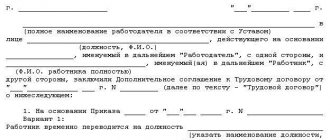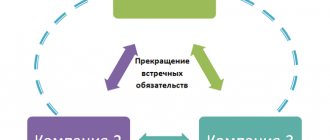A settlement agreement is a document in which the parties set out the terms of settlement of their dispute. An agreement can be drawn up when considering civil and arbitration disputes, in enforcement proceedings.
This document also has important consequences in the bankruptcy process of individuals. persons It describes the rules for repaying debts that both creditors and the debtor must comply with. Read about all the nuances of preparing and accepting agreements in our article.
Types of agreements
A settlement agreement is drawn up to resolve the dispute by agreement of the parties and to determine mutual rights and obligations.
Depending on the nature of the dispute, the document may be drawn up:
- when considering a civil or arbitration case in the courts
- in this case, the parties to the agreement will be the plaintiff and the defendant, and the document must be approved by the court; - within the framework of enforcement proceedings
, the document is drawn up by the claimant and the debtor, and the procedure for its approval is not defined by law; - during bankruptcy
- an agreement is drawn up between creditors and the debtor, and to enter into force the document is approved by the arbitration court during its meetings.
The consequences that occur after approval of the agreement in each of the listed cases are significantly different. However, signing a document always entails the termination of certain procedures - court cases, bankruptcy, enforcement proceedings.
An important nuance is that no one can be forced to sign a settlement agreement. If at least one side does not agree with him, there will be no peace. Therefore, the parties have to maneuver, make mutual concessions, and take into account each other’s interests. A settlement agreement will not be concluded by someone who is stubborn and does not want to negotiate.
Types of settlement agreements
Settlement agreements are classified into judicial and extrajudicial, although extrajudicial is rather a legal-theoretical definition. Thus, a judicial agreement is understood as the consent of the parties to a trial, which is approved by the court.
As for out-of-court settlement agreements, this is a way to resolve a legal dispute that is not related to the already begun legal process. Moreover, they can be either unapproved, that is, based only on the goodwill of the parties to the dispute, or approved.
Out-of-court settlement agreements are usually approved by arbitration courts.
Why do you need a settlement agreement in bankruptcy of individuals?
In this article we will talk about all the nuances of drawing up settlement agreements in the event of bankruptcy of an individual. If an organization goes bankrupt, only the algorithm of actions of the parties changes, but not the very essence and consequences of the procedure. For example, on behalf of the debtor organization, the document can be signed by the manager, owner or other authorized person.
The citizen himself makes the decision to conclude an agreement. However, the law does not prohibit entrusting the signing of a document to a representative.
As the word “amicable” implies, the parties must reach a compromise on all the terms of the deal and resolve the dispute peacefully. In bankruptcy this means the following:
- the debtor voluntarily agrees to begin making payments in favor of creditors on the terms specified in the document;
- creditors agree to waive subsequent stages of bankruptcy (for example, the sale of assets) and give the debtor any advantages;
- the court is obliged to check the document for compliance with the laws and make sure that its terms do not violate the interests of the parties.
The initiator of the preparation and conclusion of an agreement can be both the debtor and the creditors. The rules for drawing up a document, requirements for its form and content, are specified in Chapter VIII of Law No. 127-FZ. In relation to bankruptcy of individuals. persons there is a special article 213.31, where you can also find important information on this issue.
For the debtor
Typically, citizens file for bankruptcy to get rid of credit and other debts. But this goal can only be achieved through the sale of property (real estate, vehicles, valuables). By drawing up a settlement agreement, you can avoid the sale of property. In this case, all debts will not be written off, but you can receive significant benefits on their payments.
The main reasons why a debtor may be interested in concluding an agreement:
- you will avoid the consequences caused by bankruptcy (for example, there will be no ban on holding positions in the management bodies of the company);
- you can preserve your property, remove all prohibitions and restrictions from it;
- you can get a deferment or installment plan for payments, get creditors to forgive part of the debt;
- you can bypass the restrictions that arise when a restructuring plan is approved (for example, on the maturity of debt);
- You can save time, reduce the costs of conducting a bankruptcy case, and paying remuneration to the manager.
If creditors reveal signs of deliberate or fictitious bankruptcy, other unlawful actions on the part of the debtor, instead of being released from obligations, he will be brought to administrative or criminal liability. A settlement agreement virtually eliminates such risks, since the debtor assumes obligations to pay creditors. This is another reason why it is worth considering the option of formalizing an agreement.
For creditors
During bankruptcy, creditors have one last chance to get their money back—or at least some of it. Therefore, creditors should be interested not in completing the bankruptcy case and writing off debts, but in restoring the debtor’s solvency. This can be done by concluding a settlement agreement or approving a restructuring plan.
Having drawn up the agreement and approved it through the court, creditors:
- will receive certain guarantees that the debtor will begin to voluntarily return the money;
- will be able to apply for a writ of execution and begin collection if the debtor violates the terms of the transaction;
- may introduce additional measures of control over the debtor’s property and income if they stipulate such conditions in the agreement.
A settlement agreement in bankruptcy is drawn up by mutual agreement of the creditors and the debtor.
The agreement can specify any conditions for the fulfillment of obligations that do not contradict the law and the interests of third parties. For the agreement to take effect, it must be approved by the court.
It is always better to pay back most of the debt than to lose any chance of getting your money back. Therefore, creditors can reduce debts or write off part of the penalty, or they can give other benefits to the debtor. All these issues are discussed at meetings of creditors, during negotiations with the debtor.
Differences from debt restructuring
The essence of the restructuring plan and the settlement agreement is approximately the same. The debtor does not reach the stage of selling the property, but assumes obligations to make payments in favor of creditors. But there are also significant differences:
- the court can approve the restructuring plan without the consent of the debtor if the creditors prove a real possibility of restoring his solvency and the availability of sufficient income;
- the period of validity of the restructuring plan is precisely defined by law, while any terms can be agreed upon in the settlement agreement;
- When a document is approved by the court, there are no strict requirements for the debtor to have sufficient income to begin making payments to creditors.
If you find it difficult to assess the advantages and disadvantages of both options, consult our lawyers. It is better to take into account all the risks and nuances in advance than to fulfill obviously unfavorable conditions of creditors later.
Sample settlement agreement
_________________________________district court
cities ___________________________
SETTLEMENT AGREEMENT
g. _________________ “__”___________ ____ g.
___________________________________,
Hereinafter referred to as the “Defendant”, represented by _________________________________,
(FULL NAME)
who acts in accordance with the power of attorney issued by ______________________________ under the number _______ - one Party, as well as citizen ___________________________________________________, hereinafter referred to as (F.I.O.*)
“Plaintiff”, on whose behalf the representative ___________________________________ acts, acting in accordance with a power of attorney certified by a notary of the city _____________________________________________,
(based on license number ______, issued by “__”___________ ____),
registration entry “__” __________ ____ year under number . ___________, – the other Party, (together referred to as the Parties according to the statement of claim numbered ___________, came to a joint decision to enter into this agreement.
A settlement agreement that provides for the following conditions:
1. This document is signed by the Parties in accordance with the provisions of Art. 39, 173 Code of Civil Procedure of the Russian Federation, as well as guided by the norms of Art. 101 of the Code of Civil Procedure of the Russian Federation in order to resolve the dispute by the mutual will of both Parties, which entailed the filing of this claim.
2. According to the terms of this Settlement Agreement, the Defendant undertakes the obligation to partially satisfy the Claimant’s demands specified in the statement of claim No._______ dated “______”______________, for the total amount of_____________ (___________________________________________________________) rubles.
(size of requirements in capital letters)
3. By this Settlement Agreement, the Plaintiff confirms his complete renunciation of the substantive claims previously stated to the Defendant, which form the subject of the said statement of claim.
4. The amount of debt, in accordance with paragraph 2 of this agreement, is payable to the Plaintiff within _________ in cash at the following address:
__________________________________________________________ on the basis of a court ruling prepared in accordance with the norms of law and approving this agreement, which is presented by the Plaintiff.
5. The costs of filing a claim, legal services, and other related costs incurred by the Parties are not reimbursed.
Parties details:
Respondent: __________________________________________________________
Plaintiff: ______________________________________________________________
SIGNATURES:
_________________________________
_________________________________
_________________________________
How to write a settlement agreement without court and is it possible to do this?
It is possible, but this will not entail legally significant consequences. A document drawn up and approved without a court will not be grounds for termination of a bankruptcy case. If the debtor violates the terms of the out-of-court agreement, the creditor will not be able to automatically obtain a writ of execution in arbitration or begin forced collection.
Let us note that the option of drawing up a document without a trial can be used so that any creditor waives his claims and does not include them in the register during bankruptcy. In practice, such situations are extremely rare. In addition, out-of-court agreements can be challenged by other persons if their interests are violated.
Terms of the settlement agreement
As mentioned above, a settlement agreement is a concession between the parties to each other.
In addition to concessions related directly to the claims, the settlement agreement may provide for:
- distribution of legal costs;
- compensation for legal expenses;
- compensation for other expenses related to the consideration of the case in court, etc.
Let us pay special attention to the condition of distribution of legal costs.
If the plaintiff, when filing a claim, was exempt from paying the state fee, and the settlement agreement did not stipulate who should pay it, then approval of the settlement agreement will be refused.
We have already said that the settlement agreement should not violate the rights and interests of third parties. Failure to pay state duty is a violation of state interests.
Consequences of the settlement agreement for the debtor and creditors
After the document is approved by the court, the debtor and creditors are obliged to strictly fulfill its terms. The following consequences occur for the parties:
- the restructuring schedule is canceled if it was previously approved in the bankruptcy case;
- the moratorium on repaying creditors' claims is lifted, and the debtor is obliged to start making payments;
- encumbrances and restrictions on the disposal of property and income of the debtor are lifted;
- no sale of assets is carried out;
- The manager’s powers are terminated, and he will not receive a percentage from the sale of property.
The debtor who signed the agreement is not declared bankrupt. Consequently, he will not face the consequences of bankruptcy, including prohibitions on holding managerial positions, the obligation to notify about his bankruptcy status when receiving new loans.
Settlement Agreement Form
There is an opinion that a settlement agreement must be drawn up in writing. This is wrong. The written form is, of course, preferable, but it is quite possible to limit it to oral, especially if the agreement is not distinguished by the complexity of its terms and mutual obligations.
In this case, having filed a motion, the parties will have to dictate their settlement agreement, and the court secretary will enter it into the record.
If the settlement agreement includes many mutual obligations, then it must be submitted to the court in writing. The procedure will be as follows:
- the parties read the text of the agreement;
- the parties ask the court to approve the settlement agreement;
- the plaintiff asks the court to terminate the proceedings;
- the judge asks the parties questions to ensure that the terms of the agreement are voluntary and legal, as well as whether the agreement does not violate the rights and legitimate interests of third parties;
- the judge explains to the plaintiff the consequences of abandoning the claim;
- the judge retires to the deliberation room;
- The judge makes a ruling by which he either approves the settlement agreement or refuses to approve it.
If approval of the agreement is refused, the trial continues.







